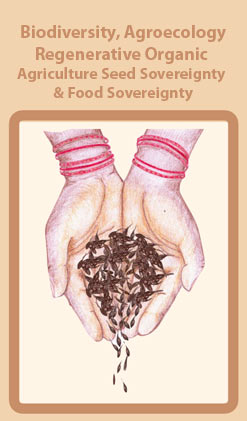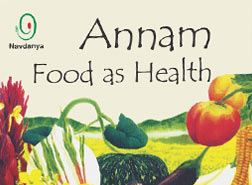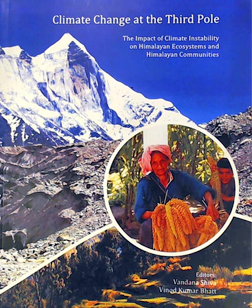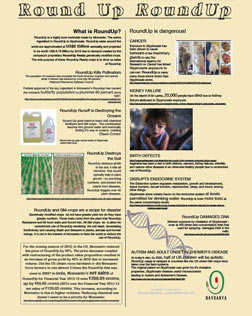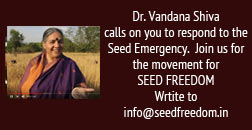The present policy draft was evolved by the team of Scientists and representatives of the community movements during the Strategic workshop on Mainstreaming Organic' at Navdanya Biodiversity conservation farm at village Ramgarh on Old Shimla Road. Following people participated in the workshop:
Dr. R.D . Gaur, Prof. Emeratus, H.N. B. Garhwal University, Srinagar Garhwal; Prof. Vir Singh, Pantnagar agriculture University; Dr. J.M.S. Rana, Director, DBT, Uttarakhand; Dr. V.P. Uniyal, WII, Dehradun; Dr. Rajesh Naithani, Advisor, CM Uttarakhand; Dr. Arvind Bhatt, Department of Biotechnology, Govt. of Himachal Pradesh; Sri Pawan Shah, Manager KM & IT, Livelihoods Improvement Project for the Himalayas, Uttarakhand; Sri Hari Raj Singh, Consultant, Soil Ecology and Disaster Management, Dehradun, Dr. R.S Rawat, Dr. Vinod Kumar Bhatt and Dr. Vandana Shiva, Managing Trustee of Navdanya.
Renewing Rural India : A Vision for Agricultural Transformation
Rural India is facing deep and multiple crises. The rural economy which supports multiple livelihoods based on agriculture is shrinking rapidly, creating a severe agrarian crisis. This is leading to large-scale migration from rural areas to cities. Combined with forced displacement, this migration is becoming non-sustainable, both for rural areas as well as urban areas. Migration is also putting the entire burden of farming on women.
The natural resources which support agriculture are also in deep crisis. The land under agriculture has shrunk due to diversion to industry and urbanization.
Water resources are drying up, soils are being degraded and biodiversity is eroding, both in forests and in agriculture, ultimately reducing the integrity of natural ecosystems. Common property resources are also being threatened. Changes in the climate are threatening agricultural production and livelihoods. Extreme climatic events, such as extended droughts and floods, are threatening life itself.
The food and nutrition crisis has emerged as a major challenge. In India, the dual malnutrition crisis due to lack of food on the one hand, and the spread of junk foods on the other hand, is threatening the health and very future of our society.
These multiple crises call for a radical shift in the paradigms and policies relating to food and agriculture.
1. Restoration of Ecological Integrity of Agro-ecosystems
Industrial chemical agriculture which relies on factories has neglected and ignored the role of species and the integrity of agro-ecosystems in contributing to food security.
A sustainable production system has to rely upon living soils, flourishing agro-biodiversity and the maintenance of nutrient and hydrological cycles. The integration between trees and forests, livestock and crops needs to be restored. The capacity of agro-ecosystems needs to be made more productive and more resilient. The self-containment features of the agro-ecosystem which arise from complexity, self-organization and diversity need to be restored by protecting, conserving and enhancing biodiversity in natural forests and farm lands.
The interconnectedness of species creates the web of life. Biodiversity provides ecosystem services at all levels from the organism to the planet. Biodiversity is not a luxury for agricultural production. The dependence on external inputs such as fertilizers, pesticides and weedicides is leading to the imbalance and disharmony in the agro-ecosystems. The harmony and balance that biodiversity creates builds fertile soils and contributes to pest and weed management without any external chemical inputs and helps conserve water.
The loss of soil nutrients and the biodiversity base is a result of continued over-exploitative approaches based on chemicals in contemporary industrial agriculture. Soil is a living system. Organic farming builds living soils through providing locally adaptable cropping practices, including mixed cropping and crop rotations, thus enriching soil nutrients. Organic farming has evolved effective and varied organic manures, such as vermicompost, vermiwash, panchagavaya ghanamrit, jeevamirit, compost and green manures. These practices lead to the rejuvenation of the soil flora and fauna, and soil fertility. Use of heavy machinery in farming is leading to soil compaction, resulting in lower infiltration and recharge of ground water and interrupting the flow of nutrients. Protecting the soil organisms, soil texture, structure and porosity and health, requires reduction in mechanical power, especially tractors in tillage operations.
Pollinators play a key role in plant reproduction and consequently in food production. The loss of natural pollinators is due to the spread of chemicals in agriculture, including the use of pesticides and fertilizers. The introduction of genetically engineered crops, including Bt crops, in agro-ecosystems is a further irreversible threat to pollinators, which carries the risk of wiping out entire species. The spread of monocultures is also threatening pollinators as pollinators are species-specific feeders and need diversity of crops. Recent studies show that electro-magnetic pollution is further disrupting pollinator ecology. Loss of pollinators such as natural bees, butterflies, birds and some other faunal species have affected agricultural production. Production of diverse indigenous crops and the practice and promotion of organic farming can play a vital role for maintaining the ecological balance of pollinators in traditional cropping systems.
Extensive use of pesticides is threatening the survival of many species of birds and insects. Pesticides are poisoning the entire food chain and food web through the process of biomagnification, and are also contaminating water systems. In the final analysis, humans do not escape the cycle of poison, which results in increased rates of chronic diseases like cancer and other health hazards.
Industrial agriculture is also leading to a water crisis due to high water demands and water pollution. This crisis is being aggravated by climate change, and demands an integrated agriculture policy based on water-prudent and climate-resilient farming. Organic farming conserves water and rejuvenates water sources. Organic farming and biodiversity also contribute to resilience in the face of climate change.
2. Sustainable Rural livelihoods
Most Indians draw their livelihoods in agriculture and agriculture is based on sustainable use of natural resources. The decline in rural livelihoods is a major aspect of the economic crisis. Rejuvenating rural livelihoods through sustainable agriculture has to be central to any policy for rural development, as well as national economic development.
The sustainability of livelihoods is dependent on the sustainability of the natural resource base. The sustainability of the natural base, in turn, is dependent on the integrity and integration of diverse components of the agro-ecosystem, including forests, grasslands, livestock, crops, agro-processing and markets. If sustainably managed, rural ecosystems have a very high potential for generating employment. However, the capacity of rural ecosystems and livelihoods to address the problems of poverty, unemployment and drudgery, and outmigration has not been fully understood and explored.
Villages are major producers of bio-resources, which can be used for food, energy, fodder, housing, fiber and medicine. Increasing the biodiversity and biological resource production in villages can meet local needs, regenerate green livelihoods and increase the participation of local communities in rebuilding the local economy. All value-added activities and processing must be based in rural areas to increase sustainable livelihoods. This would also arrest the brain drain and rural outmigration, especially of youth.
3. Traditional Knowledge, Innovation and Education
The erosion of biodiversity and other natural resources goes hand-in-hand with the erosion of indigenous application of knowledge and the life system. While chemical agriculture is chemical intensive, organic farming is knowledge intensive and relationship intensive. Indigenous communities are repositories of traditional knowledge in agriculture. This knowledge is inherited from the past over many generations, and is critical for sustaining ecosystems. The ongoing erosion of traditional knowledge in rural communities is leading to the loss of the physical resource base, undermining the evolution of sustainable agricultural practices. Traditional knowledge in farming communities needs to be recognized, preserved, valued and articulated to protect the natural resource base and augment the agricultural transformation processes.
The imposition of fragmented, reductionist knowledge, unrelated to the local ecosystems and cultures poses a great threat to the future of agriculture. The International Assessment of Agricultural Knowledge, Science and Technology for Development (2008) undertaken by the United Nations through the work of 400 experts over 4 years, has acknowledged that continued innovation on the basis of traditional knowledge has the highest potential of addressing problems in agriculture, including non-sustainability, food insecurity and livelihood insecurity. Neither chemical agriculture nor genetic engineering is able to match this potential.
All knowledge about agriculture and livelihoods has disappeared at the school level as well. The higher level education in agriculture reproduces the obsolete, fragmented chemical-based paradigm. A transformation in agriculture can only be achieved through a transformation in education from the elementary level to the university. Education needs to be more relevant to the protection of ecosystems, the regeneration of agriculture and local culture, and the generation of sustainable livelihoods. These are the pillars on which the future of our society is dependent.
4. Food Sovereignty and Nutritional Security
India had achieved self-reliance in food grains after Independence. However, nutritional diversity necessary for a balanced diet was not included as part of food security initiatives. As a result of this oversight, highly nutritious crops like millets, pulses and oilseeds were displaced from the agricultural system. This has led to the erosion of diversity and the creation of malnutrition, of which women and children, especially girls are the worst victims. One million children die before the age of five each year due to lack of adequate food. Forty-three percent of Indian children are wasted (weight too low for their age) due to severe malnourishment.
Organic farming can be a major solution to the crisis of food and nutritional insecurity. Contrary to the popular myth, organic farming produces more food per acre than monocultures and chemical farming. Since organic systems are based on crop diversity, they produce the diverse nutrients needed for a balanced diet. Organically-produced food contains more nutrients, especially micro-nutrients and trace elements, than chemically-produced food. Yield of a few monoculture crops is an inadequate assessment for nutritional security.
To address nutritional security, the food production and distribution systems need to be based on diverse nutritious crops which have been tried and tested over centuries. Rice and wheat alone do not guarantee nutritional security. Centralized monocultural systems lead to high costs and waste. Half of the food grains grown in the country are rotting due to lack of proper storage. Decentralized procurement, storage and distribution systems will reduce this waste and increase food security. Millets, like jhangora and mandua; pseudo cereals like buckwheat and ramdana; pulses and local fruits and vegetables should be part of the Public Distribution System and on public feeding programs, such as Mid-day Meals and I.C.D.S.
The domination of agricultural policy by large corporate interests is further undermining food security and nutritional security. Organic farming, and decentralized food systems for reclaiming food sovereignty is the need of our time.
Food sovereignty must be the goal of food and agriculture policy at household, local, regional and national levels. Food sovereignty means that farmers have the right to produce food. This right is dependent on the right to resources that make food production possible, including seed and genetic resources, land, pastures and forests, and water bodies. It also includes the right of all people at all times to have access to adequate, safe, affordable and culturally appropriate food. The contribution of farmers to the Indian economy needs to be honestly assessed, recognized and remunerated. Farmers and farming need to be put back at the center of planning and policy.
Urban agriculture needs to be promoted. Urban areas can also be a source of biodiversity through urban forests, rooftop farming and kitchen gardens.
Addressing malnutrition through organic farming addresses the most serious challenge we face in terms of the health of our future generations.
5. Rights and Access to Resources
Farming communities have been the custodians of natural resources in all areas for millennia. Farmers have continuously utilized and increased biodiversity in cultivated areas, and contributed to on-farm conservation of biodiversity. They have built the soil and conserved water resources. They have also carried over the biodiversity, especially seeds and knowledge, to future generations. Along with the erosion of these vital resources, there has been an erosion of rights of farmers to land and natural resources. Forced displacement and uprooting of farmers is the most serious conflict in the country today. Agricultural land that is vital to food security and farmers’ livelihood should not be diverted to industrialization and urbanization. For this, an appropriate land-use policy needs to be developed.
The rights of farmers to their natural resources are inalienable and guaranteed through customary rights. These customary rights need to be recognized and protected as the human rights of farmers. They also need to be recognized, because without farmers’ rights and dignity, there can be no food sovereignty and no food security.
Farmers’ natural rights to save seeds and their community intellectual rights to indigenous knowledge are under threat by new intellectual and patent laws. Farmers’ rights to save seeds is inalienable, as has been stated in the Farmer’s Rights and Plant Variety Act. However, there are attempts to undermine farmers’ rights through the proposed seed act. Corporations are also interpreting the law on their own terms to create seed monopolies as illustrated of the case of Andhra Pradesh vs. Monstanto.
Water resources in rural areas are being diverted to industry and urban areas. Forests are being destroyed, leading to a de-greening of the countryside.
The farmers’ rights to their land, their seed, their forests and pastures and water are community rights. Farmers need to be recognized as conservers of these resources. Their contribution to the national economy is not just in terms of food security, but also in terms of the ecological security of the country. The rejuvenation of the rural economy needs a transformation of the colonial laws that policed the people and rewarded the plunderers. Food sovereignty rests on recognition of the multiple, collective rights of farmers to freely conserve, produce, process and sell what they rear and cultivate. Farmers need to be informed, and need to participate as equals in the creation of policies for sustainable use of natural resources to avoid confusion, conflicts and non-sustainable exploitation.
Learning lessons from the multiple crises we face in agriculture can become a new opportunity for rejuvenating our agro-ecosystems, our knowledge systems, our livelihood systems, our cultures and participatory democracy.
Organic farming, in essence, can contribute to social-cultural cohesion, increase in social happiness and a sense of fullness of life, while bringing prosperity to rural areas and health and well being to society at large. This is an opportunity we cannot afford to miss.
B. Action Plans:
1. rejuvenating ecological integrity of agro-ecosystems:
a. biodiversity conservation
i. identify biodiverse zones as conservation zones
ii. community seed banks
iii. on-farm conservation of biodiversity (seeds, livestock)
iv. regeneration and protection of forests through community participation
b. soil and water conservation
i. protection of natural forests for their water conservation function
ii. rejuvenating forests with species that conserve soil and water
iii. rain water harvesting through traditional practices (chal, khal and taal)
iv. promotion of water prudent crops
v. planting of hedges and field banks with water and soil conserving species
c. integrate various institutions working in agriculture and natural resource management
i. horizontally across institutions and agencies
ii. vertically with local communities and panchayat to ensure community participation
2. Sustainable rural livelihoods
a. Promotion of agricultural livelihoods through organic farming and community farming by
i. bringing dignity to agricultural livelihoods
ii. celebrating local food and agricultural traditions through biodiversity festivals and food festivals
iii. promoting organically grown high value crops
iv. multiple activities such as beekeeping, sericulture, renewable energy
b. Conservation of indigenous livestock breeds that are hardy, efficient converters of feed to food and multifunctional in their product output
c. Recognizing and upholding pastoral economies and their natural resource base
d. Conservation and promotion of undomesticated biodiversity for food health, fodder, fuel, manures, shelter and crafts
e. Promotion of artisanal cottage industries based on biodiversity and agro-processing
f. Facilitating effective post-harvest management including storage and preservation of perishable fruits and vegetables
g. Creation of fair trade markets through cooperative marketing of
i. organic produce
ii. artisanal products
h. Facilitating entire supply chain management including packaging and branding to increase incomes of rural producers
i. Promoting participatory guarantee systems and local certification
j. Promotion of organic cafes and restaurants based on local foods and local cuisine
k. Promotion of organic tourism linking it to spiritual tourism and ecotourism
l. The Green Mission and all other missions of the government should support livelihoods for local people for re-greening forests and farms with indigenous species and for rejuvenating local resources
3. Traditional knowledge, innovation and education
a. Documentation of indigenous knowledge and biodiversity
i. Community biodiversity registers
b. Introduction of organic farming from primary school to university level
c. Farmer’s field schools for organic farming
d. Creation of organic gardens in schools and communities in rural and urban areas to educate the children and the public about the soil, the seed, water and nutrition, and providing incentives to the best practitioners
e. Creation of centers of excellence for organic farming for education of men and women farmers, rural and urban youth and decision-makers
f. Innovation centers in rural area for participatory research on integrated management of ecosystems and organic agriculture
g. Research in universities, agricultural institutions and research and development institutions should stop imposing alien categories, concepts and models and should start relating to the traditional knowledge and needs of the people, the variation of local conditions and should spearhead the organic movement.
h. Community organizations, voluntary organizations and NGOs need to be an integral part of the knowledge revolution which reconnects agriculture to ecological processes and the farming community
4. Food and Nutritional Security
a. Documentation, promotion and reintroduction of traditional nutritional crops in organic farming
b. Documentation, promotion and reintroduction of traditional processing methods that maintains the quality, nutrition and taste of food
c. Campaigns for creation of nutritional literacy, indigenous gastronomy and local slow-food cultures
d. Introduction of traditional nutritional produce in the PDS, Mid-Day Meal and ICDS
e. Support women’s groups for producing nutritious foods with traditional crops to conserve the food heritage
f. Research on assessment of the nutrition, taste and quality of traditional crops
5. Rights and Access to Resources
a. Farmers’ right to land must not be undermined. For this, the 1894 Colonial Land Acquisition Act must be replaced with a Farmer’s Land Sovereignty Act
b. Common lands (CPRs) must be protected with legal rights. Any handing over of community lands to private interests should be stopped
c. Farmers’ right to seed and breeds and the community intellectual property rights of farming communities to their knowledge and biodiversity needs to be enshrined in every law
d. Water should be recognized as a common and public good. The United Nations has recognized the right to water as a human right. For farming communities, the right to water includes the right to drinking water and the right to water for irrigation.
e. The diversion of water from agriculture to hydropower projects and dams as well as to industry and urban areas is a threat to agriculture, farming communities and entire ecosystems. It is an eco-cidal trend and must be stopped immediately. The right of the river to flow freely and support and sustain the life of communities and ecosystems must be recognized.
f. Instead of rewarding the wasters and polluters with more water, a culture of water conservation and water consciousness must be rejuvenated.
g. Farmers’ right to knowledge needs to be defended from biopiracy and patenting. For this biopiracy must be made illegal in the WTO TRIPS agreement. All national laws should recognize the community intellectual rights of the farmers.
h. The well being and happiness of our communities must not be compromised. The government of Bhutan has institutionalized the Gross National Happiness as the measure of its prosperity, wealth and well being. This should inspire our panchayats, state governments and the national government to make appropriate changes to policies and laws.
i. The integrity of our ecosystems and the planet need a shift in consciousness. The universal declaration of the rights of mother earth proposed by Bolivia must inspire the basis of national and state laws regarding natural resources and agriculture.
The present policy draft was evolved by the team of Scientists and representatives of the community movements during the Strategic workshop on Mainstreaming Organic' at navdanya Biodiversity conservation farm at village Ramgarh on Old Shimla Road. Following people participated in the workshop:
Dr. R.D . Gaur, Prof. Emeratus, H.N. B. Garhwal University, Srinagar Garhwal; Prof. Vir Singh, Pantnagar agriculture University; Dr. J.M.S. Rana, Director, DBT, Uttarakhand; Dr. Rajesh Naithani, Advisor, CM Uttarakhand; Dr. Arvind Bhatt, Department of Biotechnology, Govt. of Himachal Pradesh; Sri Pawan Shah, Manager KM& IT, Livelihoods Improvement Project for the Himalayas, Uttarakhand; Sri Hari Raj Singh, Consultant, Soil Ecology and Disaster Management, Dehradun, Dr. R.S Rawat, Dr. Vinod Kumar Bhatt and Dr. Vandana Shiva, Managing Trustee of Navdanya.


